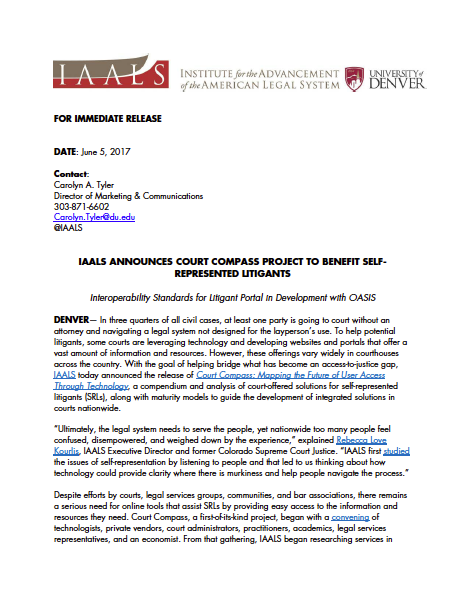IAALS Announces Court Compass Project to Benefit Self-Represented Litigants
Interoperability Standards for Litigant Portal in Development with OASIS
 In three quarters of all civil cases, at least one party is going to court without an attorney and navigating a legal system not designed for the layperson’s use. To help potential litigants, some courts are leveraging technology and developing websites and portals that offer a vast amount of information and resources. However, these offerings vary widely in courthouses across the country. With the goal of helping bridge what has become an access-to-justice gap, IAALS today announced the release of Court Compass: Mapping the Future of User Access Through Technology, a compendium and analysis of court-offered solutions for self-represented litigants (SRLs), along with maturity models to guide the development of integrated solutions in courts nationwide.
In three quarters of all civil cases, at least one party is going to court without an attorney and navigating a legal system not designed for the layperson’s use. To help potential litigants, some courts are leveraging technology and developing websites and portals that offer a vast amount of information and resources. However, these offerings vary widely in courthouses across the country. With the goal of helping bridge what has become an access-to-justice gap, IAALS today announced the release of Court Compass: Mapping the Future of User Access Through Technology, a compendium and analysis of court-offered solutions for self-represented litigants (SRLs), along with maturity models to guide the development of integrated solutions in courts nationwide.
 “Ultimately, the legal system needs to serve the people, yet nationwide too many people feel confused, disempowered, and weighed down by the experience,” explained Rebecca Love Kourlis, IAALS Executive Director and former Colorado Supreme Court Justice. “IAALS first studied the issues of self-representation by listening to people and that led to us thinking about how technology could provide clarity where there is murkiness and help people navigate the process.”
“Ultimately, the legal system needs to serve the people, yet nationwide too many people feel confused, disempowered, and weighed down by the experience,” explained Rebecca Love Kourlis, IAALS Executive Director and former Colorado Supreme Court Justice. “IAALS first studied the issues of self-representation by listening to people and that led to us thinking about how technology could provide clarity where there is murkiness and help people navigate the process.”
Despite efforts by courts, legal services groups, communities, and bar associations, there remains a serious need for online tools that assist SRLs by providing easy access to the information and resources they need. Court Compass, a first-of-its-kind project, began with a convening of technologists, private vendors, court administrators, practitioners, academics, legal services representatives, and an economist. From that gathering, IAALS began researching services in existence in state and federal courts, like self-help content, video libraries, mobile apps, e-filing and smart forms, live chat and text messaging, online dispute resolution and online legal advice, and scheduling tools. By compiling the services currently available and those in development, courts can learn from one another and embrace solutions that benefit the most people.
The report also ranks the states with the widest range of online services (California, New York, Massachusetts, Arizona, and Utah being the top five), and identifies the trending technologies (online dispute resolution, litigant case manager with an online portal, and case alerts and tracking). Simultaneous to the report’s release, IAALS made its entire database publicly available for all to explore.
“Our findings also identified the greatest challenges preventing widespread adoption of these technologies: content development, integration, and cost,” said Kourlis. “To overcome these challenges, IAALS is now working with the international standards group OASIS to streamline the dream of a litigant portal in every courthouse.”
Because it is unlikely that most organizations will be able to build a complete portal, it is critical that modules created by different sources be interoperable. The OASIS Litigant Portal Technical Committee is currently developing technical standards to mitigate the interoperability challenges. Participant organizations include DXC Technology; Florida Justice Technology Center; Greacen Associates; Intresys; Journal Technologies; Los Angeles County Superior Court; Microsoft; MTG Management Consultants, LCC; National Center for State Courts; One Legal; and Tyler Technologies, in addition to IAALS. By working collectively, the participants hope to solve issues of scaling, flexibility, and cost associated with full-scale litigant portals. The committee is on track to have standards developed within nine to 12 months.
“When we harness it appropriately, technology has the power to serve and change how people experience the legal system and whether they feel they have access to justice,” concluded Kourlis.





